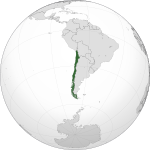Chile
Kasa Mai zaman kanta a kudancin America
Chile kasa ne, da ke a nahiyar Amurka. Babban birnin Chile, Santiago ne.
|
República de Chile (es) Chile (es) | |||||
|
|||||
 | |||||
|
| |||||
| Take |
National Anthem of Chile (en) | ||||
|
| |||||
|
| |||||
| Kirari |
«Por la razón o la fuerza» «By Right or Might» «Durch Überzeugung oder mit Gewalt» «Drwy Gyfiawnder neu Rym» | ||||
| Wuri | |||||
| |||||
| Babban birni | Santiago de Chile | ||||
| Yawan mutane | |||||
| Faɗi | 19,458,000 (2021) | ||||
| • Yawan mutane | 25.73 mazaunan/km² | ||||
| Harshen gwamnati | Yaren Sifen | ||||
| Labarin ƙasa | |||||
| Bangare na |
Latin America (en) | ||||
| Yawan fili | 756,102 km² | ||||
| Wuri a ina ko kusa da wace teku | Pacific Ocean | ||||
| Wuri mafi tsayi |
Ojos del Salado (en) | ||||
| Wuri mafi ƙasa | Pacific Ocean (0 m) | ||||
| Sun raba iyaka da | |||||
| Bayanan tarihi | |||||
| Ƙirƙira | 18 Satumba 1810 | ||||
| Muhimman sha'ani | |||||
| Tsarin Siyasa | |||||
| Tsarin gwamnati |
Democratic Republic (en) | ||||
| Majalisar zartarwa |
Cabinet of Chile (en) | ||||
| Gangar majalisa |
National Congress of Chile (en) | ||||
| • President of Chile (en) |
Gabriel Boric (en) | ||||
| Ikonomi | |||||
| Nominal GDP (en) | 316,713,577,509 $ (2021) | ||||
| Kuɗi |
Chilean peso (en) | ||||
| Bayanan Tuntuɓa | |||||
| Kasancewa a yanki na lokaci | |||||
| Suna ta yanar gizo |
.cl (mul) | ||||
| Tsarin lamba ta kiran tarho | +56 | ||||
| Lambar taimakon gaggawa |
131 (en) | ||||
| Lambar ƙasa | CL | ||||
| Wasu abun | |||||
|
| |||||
| Yanar gizo | thisischile.cl… | ||||

Tarihi
gyara sasheMulki
gyara sasheArziki
gyara sasheWasanni
gyara sasheFannin tsarotsaro
gyara sasheKimiya da Fasaha
gyara sasheSifiri
gyara sasheSifirin Jirgin Sama
gyara sasheSifirin Jirgin Kasa
gyara sasheAl'adu
gyara sasheMutane
gyara sasheYaruka
gyara sasheAbinci
gyara sasheTufafi
gyara sasheIlimi
gyara sasheAddinai
gyara sasheMusulunci
gyara sasheKiristanci
gyara sasheHotuna
gyara sashe-
National Congress, Legislative Power
-
Comptroller General of Chile
-
Wani daji a cikin kasar Chile
-
Rafi mai kyau a kasar Chile
-
Lardin kasr Chile a hange daga sararin samaniya
-
Ziyaram kasar Chile a shekaran 1890
-
Ziyaram kasar Chile a shekaran 1890
-
University of La Frontera, Temuco
Manazarta
gyara sasheWannan Muƙalar guntuwa ce: tana buƙatar a inganta ta, kuna iya gyara ta.



